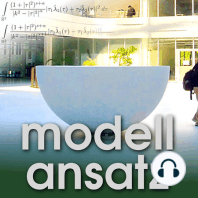31 Min. hören
Homogenization
VonModellansatz
Bewertungen:
Länge:
56 Minuten
Freigegeben:
1. Dez. 2016
Format:
Podcastfolge
Beschreibung
Andrii Khrabustovskyi works at our faculty in the group Nonlinear Partial Differential Equations and is a member of the CRC Wave phenomena: analysis and numerics. He was born in Kharkiv in the Ukraine and finished his studies as well as his PhD at the Kharkiv National University and the Institute for Low Temperature Physics and Engineering of the National Academy of Sciences of Ukraine. He joined our faculty in 2012 as postdoc in the former Research Training Group 1294 Analysis, Simulation and Design of Nanotechnological Processes, which was active until 2014. Gudrun Thäter talked with him about one of his research interests Asymptotic analysis and homogenization of PDEs. Photonic crystals are periodic dielectric media in which electromagnetic waves from certain frequency ranges cannot propagate. Mathematically speaking this is due to gaps in the spectrum of the related differential operators. For that an interesting question is if there are gaps inbetween bands of the spectrum of operators related to wave propagation, especially on periodic geometries and with periodic coeffecicients in the operator. It is known that the spectrum of periodic selfadjoint operators has bandstructure. This means the spectrum is a locally finite union of compact intervals called bands. In general, the bands may overlap and the existence of gaps is therefore not guaranteed. A simple example for that is the spectrum of the Laplacian in which is the half axis . The classic approach to such problems in the whole space case is the Floquet–Bloch theory. Homogenization is a collection of mathematical tools which are applied to media with strongly inhomogeneous parameters or highly oscillating geometry. Roughly spoken the aim is to replace the complicated inhomogeneous by a simpler homogeneous medium with similar properties and characteristics. In our case we deal with PDEs with periodic coefficients in a periodic geometry which is considered to be infinite. In the limit of a characteristic small parameter going to zero it behaves like a corresponding homogeneous medium. To make this a bit more mathematically rigorous one can consider a sequence of operators with a small parameter (e.g. concerning cell size or material properties) and has to prove some properties in the limit as the parameter goes to zero. The optimal result is that it converges to some operator which is the right homogeneous one. If this limit operator has gaps in its spectrum then the gaps are present in the spectra of pre-limit operators (for small enough parameter). The advantages of the homogenization approach compared to the classical one with Floquet Bloch theory are: The knowledge of the limit operator is helpful and only available through homogenization. For finite domains Floquet Bloch does not work well. Though we always have a discrete spectrum we might want to have the gaps in fixed position independent of the size of our domain. Here the homogenization theory works in principle also for the bounded case (it is just a bit technical). An interesting geometry in this context is a domain with periodically distributed holes. The question arises: what happens if the sizes of holes and the period simultaneously go to zero? The easiest operator which we can study is the Laplace operator subject to the Dirichlet boundary conditions. There are three possible regimes: For holes of the same order as the period (even slightly smaller) the Dirichelet conditions on the boundary of holes dominate -- the solution for the corresponding Poisson equation tends to zero. For significantly smaller holes the influence on the holes is so small that the problem "forgets" about the influence of the holes as the parameter goes to zero. There is a borderline case which lies between cases 1 and 2. It represents some interesting effects and can explain the occurance of so-called strange terms. A traditional ansatz in homogenization works with the concept of so-called slow and fast variables. The
Freigegeben:
1. Dez. 2016
Format:
Podcastfolge
Titel in dieser Serie (100)
Versuchsplanung: Modellansatz 022 von Modellansatz
